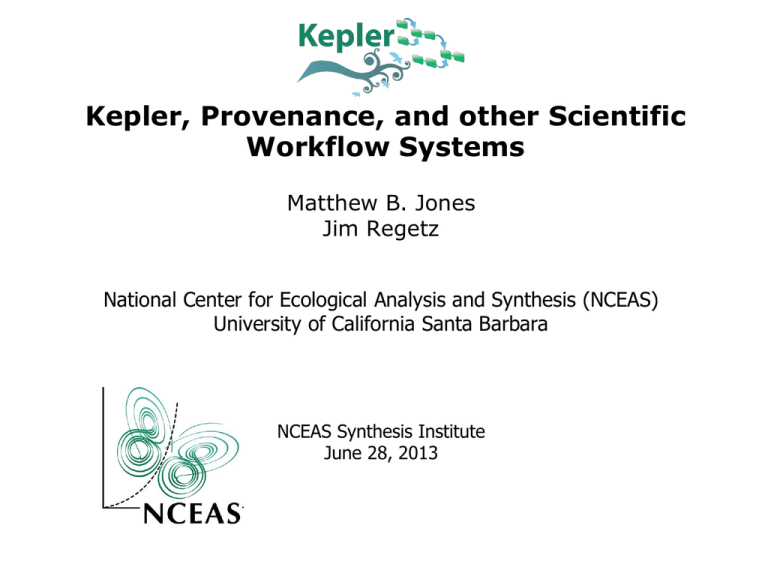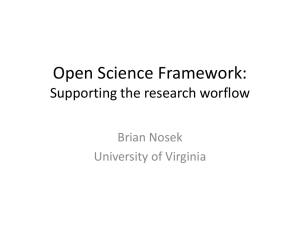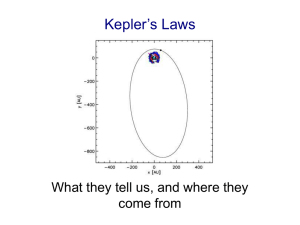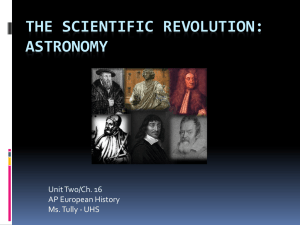
Kepler, Provenance, and other Scientific
Workflow Systems
Matthew B. Jones
Jim Regetz
National Center for Ecological Analysis and Synthesis (NCEAS)
University of California Santa Barbara
NCEAS Synthesis Institute
June 28, 2013
Diverse Analysis and Modeling
• Wide variety of analyses used in ecology and
environmental sciences
– Statistical analyses and trends
– Rule-based models
– Dynamic models (e.g., continuous time)
– Individual-based models (agent-based)
– many others
• Implemented in many frameworks
– implementations are black-boxes
– learning curves can be steep
– difficult to couple models
Scientific workflows
• Workflow as instance
– The workflow is the process!
• Two major approaches
– Scripted workflows
• in R, or Python, or bash, or ...
– Dedicated workflow engines
• Kepler and others
Let’s focus on
this for a
while
•
Goals
•
Produce an open-source scientific workflow system
•
Support scientists in a variety of disciplines
•
Important features
•
•
•
•
•
•
•
•
•
design, share, and execute scientific workflows
e.g., biology, ecology, oceanography, astronomy
access to scientific data
works across analytical packages
simplify distributed computing
clear documentation
effective user interface
provenance tracking for results
model archiving and sharing
Kepler use cases represent many science
domains
• Ecology
• Physics
– SEEK: Ecological Niche Modeling
– CPES: Plasma fusion simulation
– COMET: environmental science
– FermiLab: particle physics
– REAP: Parasite invasions using sensor networks
• Geosciences
– GEON: LiDAR data processing
– GEON: Geological data integration
• Molecular biology
– SDM: Gene promoter identification
– ChIP-chip: genome-scale research
– CAMERA: metagenomics
• Oceanography
– REAP: SST data processing
– LOOKING: ocean observing CI
– NORIA: ocean observing CI
– ROADNet: real-time data modeling
– Ocean Life project
• Phylogenetics
• ATOL: Processing Phylodata
• CiPRES: phylogentic tools
• Chemistry
• Resurgence: Computational
•
chemistry
DART (X-Ray crystallography)
• Library Science
• DIGARCH: Digital preservation
• Cheshire digital library: archival
• Conservation Biology
• SanParks: Thresholds of Potential
Concerns
Anatomy of a Kepler Workflow
Actors
Channels
Tokens
int, string, record{..}, array[..], ..
Ports
Kepler scientific workflow system
Data source from
repository
R processing script
res <- lm(BARO ~ T_AIR)
res
plot(T_AIR, BARO)
abline(res)
Run Management
Each execution recorded
Provenance of derived data recorded
Can archive runs and derived data
A Simple Kepler Workflow
Component
Tab
Searchable
Component
List
Workflow Run Manager
Component Documentation
Data preparation
FORTRAN code
MATLAB code
Data Access
Accessing Data in Kepler
•
•
•
•
•
•
•
File system (e.g., CSV files)
Catalog searches (e.g., KNB)
Remote databases (e.g., PostgresQL)
Web services
Data access protocols (e.g., OPeNDAP)
Streaming data (e.g., DataTurbine)
Specialized repositories (e.g., SRB)
• etc., and extensible
Direct
Data Access to Data Repositories
Search for
metadata
term
(“ADCP”)
Drag to workflow area to create
datasource
398 hits for ‘ADCP’ located in
search
OPeNDAP
• Directly access OPeNDAP servers
• Apply OPeNDAP constraints for
remote data subsetting
• Current work: searchable catalogs
across OPeNDAP servers
Gene sequences via web services
Gene sequence returned
in XML format
Extracted sequence
can be returned for
further processing
Web service executes
remotely (e.g., in Japan)
This entire workflow can be
wrapped as a re-usable component
so that the details of extracting
sequence data are hidden unless
needed.
Benthic Boundary Layer Project:
Kilo Nalu, Hawaii
Benthic Boundary Layer Geochemistry and Physics at the Kilo Nalu Observatory
G. Pawlak, M. McManus, F. Sansone, E. De Carlo, A. Hebert and T. Stanton
NSF Award #OCE-0536607-000
•Research instruments are part of cabled-array at the Kilo Nalu Observatory
•Deployed off of Point Panic, Honolulu Harbor, Hawai’i
•Goal: Measure the interactions between physical oceanographic forcing, sediment alteration, and
modification of sediment-seawater fluxes
Accessing sensor streams at Kilo Nalu
Support application scripts
in R, Matlab, etc.
Streaming Data
from observatory
DataTurbine Server
now <- Sys.time()
Epoch <- now - as.numeric(now)
timeval <-Epoch + timestamps
posixtmedian = median(timeval)
Modular components,
mediantime = as.numeric(posixtmedian)
easily saved and shared
meantemp = mean(data)
Graphs and derived
data can be
archived and displayed
Composite actors aid comprehension
Composite actors aid comprehension
• Save components
• for later re-use
• Share components
• via external repositories
Workflow archiving and sharing
Archiving isn’t just for data...
• Kepler can archive and version:
– Analysis code and workflows
– Results and derived data
• e.g., data tables, graphs, maps
– Derived data lineage
• What data were used as inputs
• What processes were used to generate the
derived products
Run Management & Sharing
• Provenance subsystem
monitors data tokens
Scheduling remote execution
Viewing remote runs
•
Grid Computing
Grid computing
• Support for several grid technologies
–
–
–
–
Ad-hoc Kepler networks (Master-Slave)
Globus grid jobs
Hadoop Map-Reduce
SSH plumbed-HPC
Sensor sites: topology and monitoring
Open Source Community
Open Kepler Collaboration
• http://keplerproject.org
• Open-source
– BSD License
• Collaborators
– UCSB, UCD,
UCSD, UCB,
Gonzaga, many
others
Ptolemy II
Community Contribution:
Kepler/WEKA
from Peter Reutemann
Community Contribution:
Science Pipes
from Paul Allen, Cornell Lab of Ornithology
Advantages of Scientific Workflows
• Mix analytical systems
– Matlab, R, C code, FORTRAN, other executables, ...
• Understand models
– visually depict how the analysis works
• Directly access data
• Utilize Grid and Cloud computing
• Share and version models
– allow sharing of analytical procedures
– document precise versions of data and models used
• Provide provenance information
– provenance is critical to science
– workflows are metadata about scientific process
Other Workflow Systems
http://www.taverna.org.uk/
Taverna Workbench
http://www.vistrails.org/
VisTrails
Pegasus
http://www.trianacode.org/
Triana
myexperiment.org
A case study:
Thresholds of Potential Concern
(TPCs) from
Kruger National Park
Kruger National Park
• Flagship of the South African
National Parks system
• Established in 1898
• Diverse ecosystems across
nearly 2 million hectares
KNP Scientific Services
• Plan and conduct conservation
research
• Identify and avert biodiversity threats
overabundance
invasives
pollutants
development
resource exploitation
climate change
• Provide scientific inputs to
management
Thresholds of Potential Concern (TPCs)
• Upper/lower limits to environmental indicators
• Based on long-term monitoring data quantifying
variability in relevant factors
• Used to determine whether pre-defined conditions
have been exceeded
• …so that management decisions can be made, and
their empirical outcomes carefully documented
Some TPC examples...
• Animal populations
– Acceptable densities and growth rates
• Landscape/ecosystem types
– Enough heterogeneity at various scales
• Fires
– Appropriate mix of size, intensity, location
• River flow
– Not too low; high with some frequency
TPC Exceedance
Exceedance of a TPC
indicates an ecological
condition within Kruger
that is of serious concern
TPC Exceedance
http://www.sanparks.org/parks/kruger/conservation/scientific/mission/TPC.jpg
Practical Challenges of Implementing
TPCs
•
•
•
•
•
•
Acquiring the necessary data
Interpreting and preprocessing the data
Faithfully implementing the TPC “rules”
Getting answers quickly and reliably
Translating results into recommendations
Ensuring transparency of the process
Bovine Tuberculosis (BTB)
Mycobacterium bovis
– Invasive organism within African ecosystems
– In KNP since early 1960s, likely originating from
infected domestic cattle
– Detected in ten wildlife species
• buffalo, lion, leopard, cheetah, hyena, kudu, baboon,
warthog, honey badger, genet
– Buffalo are the primary host
Bovine Tuberculosis (BTB)
• Concern: BTB impacts on biodiversity
“Significant measured or predicted (through
modeling) negative effects on population
growth and structure, and long-term viability
of a species that can be attributed to BTB”
The Buffalo BTB TPC
• “A decline in zonal population growth
rate to below 5% (normal growth rate
8% to 12%) in three consecutive
years during a wet cycle, in a total
buffalo population of less than 30
000”
– wet cycle = “a mean annual rainfall for
three consecutive years, including the
year under consideration, above the
long-term annual mean”
Scientific workflows document adaptive
management
The Buffalo TPC
Data on local
hard drive
‘Wet cycle’
assessment
Buffalo
population
assessment
Display
results
Benefits of Kepler for TPCs
• Visually depict how the TPC works
• Clarify how execution takes place
• Facilitate rapid review and revision
• Provide direct access to data, via links to local or
network storage
• Execute TPCs on a schedule with new data
• Enable efficient execution and sharing of results,
even for those with minimal quantitative skills
River Flow TPC
Data input
from KNB
Data prep
TPC analysis
Base flow
High flow
Output display
River Flow TPC
Base flow
results
High flow
results
River Flow TPC
High flow
Base
flow
results
In summary…
• Typical analytical models are complex and difficult to
comprehend and maintain
• Scientific workflows provide
– An intuitive visual model
– Structure and efficiency in modeling and analysis
– Abstractions to help deal with complexity
– Direct access to data
– Means to publish and share models
• Kepler is an evolving but effective tool for scientists
– Kepler/CORE award funds transition from research prototype
to production software tool












